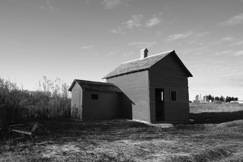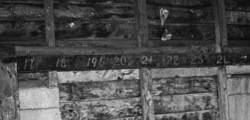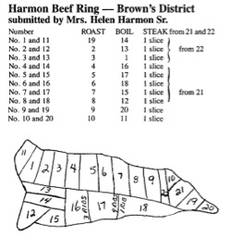The Beef Ring – A Cooperative Success
For the first few years many settlers had a diet that was a bit low on beef. Wild game could fill that void but most settlers had a taste for beef. Establishing a stock of chickens and pigs could be done relatively quickly, but it took a while to establish a herd of cattle.
Before long however, most farms had a few milk cows and produced a few calves. Some were sold off and some were destined for the home dinner table. Of course you slaughtered cattle in the late fall, so that nature’s freezer (Thank you prairie climate!) was at your disposal. Killing a steer in the summer left even a very large family with too much meat to store.
So what they did was cooperate. Each week one member contributed a steer. They divided it amongst the members in a fair manner. Everyone got fresh beef each week. Brilliant!
The Purple Hill Beef Ring was a fine example. It was organized in February of 1908. J.E. Mills and Willis Baskier were butchers at $3 per head plus the hide. There were 20 shares, with one or two members per share. That made for a twenty-week season starting in May.
All beef rings were inspected and operated under an annual license from the Department of Health. A slaughterhouse was built in a central location. When it was your turn to provide the beef on the hoof, you got it to the slaughterhouse the night before the butcher was to arrive. With careful organization the butcher would see to it that the various cuts were allotted fairly so that each family got their fair share of the choice cuts. At the end of the season it should all work out that each shareholder got a full beef.
The meat was placed in white cotton bags supplied by each member with their names stitched on the outside. Sugar bags served the purpose quite well. Some beef rings had the members take turns delivering the meat, others placed each order on pegs on the wall and people picked them up. That duty might well fall upon an older child. Most farms had an ice-house, a well, or a cool basement for temporary storage. Some even built an “ice well” by filling a well with ice in the winter, covering it with sawdust, and building a shelter over it. Rules may have varied slightly. One ring dictated that the farmer who donated the animal that week received the head, heart, tail, tongue, suet and legs. Another allowed that if you could not supply an animal each year you could make arrangements with someone else to supply it and you would settle with the donor. It was all very flexible.
Some systems like the Harmon Beef Ring north of Melita were quite detailed:


Each community beef ring has its stories. There was the time when a vehicle – bovine traffic mishap caused a last minute substitution as the accident victim replaced the previously selected condemned steer. Sometime the steers were hard to manage –they refused to go quietly and had to be shot first, then transported to the slaughterhouse.
But the beef always got to the table.
With the advent of rural electrification and the availability of affordable home freezers, the need for the Beef Ring faded. Some like the Richview club, near Boissevain operated until 1954 when it was refused a licence because the slaughterhouse wasn’t equipped with running water or hydro.
Progress is good, but still… so was the idea of working together to improve one’s life. And it must have been interesting, looking forward to seeing what cuts of meat would be on the menu this week.
Just an aside: Does anyone else find it a bit odd that the Purple Hill Beef Ring marked their annual fall meeting with – of all things – an oyster supper!

One of the few Beef Ring buildings left standing in Manitoba is this Designated Heritage Site, near Gilbert Plains Mb.
. . . . .
Author: Ken Storie
Sources:
Brenda History Committee. Bridging Brenda Vol. 1. Altona. Friesen Printers, 1990 Images:
Melita - Arthur History Committee. Melita: Our First Century. Altona. Friesen Printers, 1983. pp 60 Ken Storie, 2009
